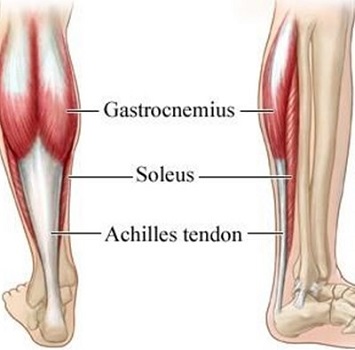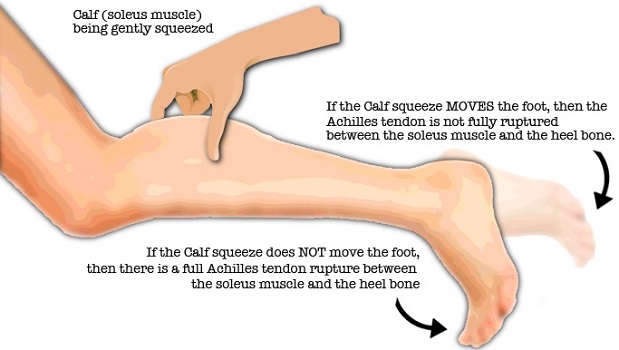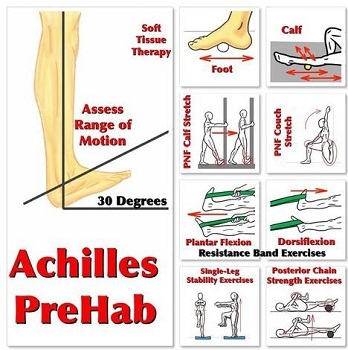The Achilles tendon is one of the longest tendons in our body. It’s the elastic band of tissue that connects your calf muscles to your heel bone, and you use it for each step you are taking. Whenever you walk, run, jump, dance, or do something that needs the use of your legs, you’re engaging your Achilles tendon. The Achilles tendon is often injured. Achilles tendon rupture happens once it stretches the tendon beyond its capacity. Forceful jumping or pivoting, or unexpected running accelerations, will injure the tendon and cause a tear and result from falling or tripping. Ruptured Achilles tendon treatment depends on how severe your injury is (partial rupture of Achilles tendon or full rupture of Achilles tendon). Ruptured Achilles tendon recovery time depends on your injury severity, rehab program, and how well your tendon heals.
Your doctor or physical therapist can offer you an idea of when you will return to your activities.
Achilles Tendon Anatomy
The Achilles tendon is a robust band of fibrous tissue that connects the calf muscles to the heel bone (calcaneus). The Achilles tendon is additionally known as the calcaneal tendon. The gastrocnemius and soleus muscles unite (calf muscles) into one tissue band, which turns into the Achilles tendon at the low end of the calf. The Achilles tendon then enters the heel bone. Small sacs of fluid known as bursae cushion the Achilles tendon at the heel.

The Achilles tendon is the widest and strongest tendon in our body. Once the calf muscles flex, the Achilles tendon pulls on the heel. This movement permits us to stand on our toes while walking, running, or jumping. Despite its strength, the Achilles tendon is also liable to injury because of its limited blood supply and the high tensions placed on that.
Blood supply of the Achilles tendon
The Achilles tendon receives its blood supply from several sources. Tiny blood vessels cross the tendon sheath to supply blood and nutrients to the tendon. The tendon sheath additionally has tiny arteries that help supply the tendon. However, there’s a relative lack of blood supply within the lower part of the tendon just above where it inserts into the heel, and lack of blood flow is also associated with the tendon rupture location.
Achilles Tendon Function
The tendon forms from gastrocnemius and soleus muscles within the back of the calf, about 6 inches higher than the ankle joint, and spirals as it crosses the ankle to attach to the heel bone (calcaneus). A sheath surrounds the tendon, permitting it to glide easily as the ankle joint moves through its range of motion.
Since the calf muscles arise on top of the knee and the Achilles attaches below the ankle, the muscle-tendon unit’s function is crucial for walking and running. Once the calf muscle contracts, it causes the ankle to point the foot downward and, therefore, the foot to turn inward and up. The tendon must be robust. Running and climbing stairs generate force within the tendon equal to 10 times the body’s weight.
Ruptured Achilles Tendon Causes
Achilles tendon rupture happens in athletic individuals between ages 30 and 50 and largely in men (6:1 men: women). The majority have had no previous history of pain or previous injury to the tendon. In most cases, the Achilles tendon rupture happens 2-6 cm on top of the insertion of the tendon into the heel bone.
The Achilles tendon incorporates a huge job from running, jumping, and all of our daily activities. However, Achilles is also at risk of tendonitis, an inflammation of the tendon, and rupture, a condition related to overuse or degeneration.
In an Achilles rupture, the tendon of the Achilles itself tears either partially or fully. This could happen for degeneration, during which the connective tissue loses its organized structure and will develop microscopic tears over time or will happen acutely from an injury.
Usually, the Achilles ruptures once there’s a sudden, forceful movement of the foot downward against resistance; like once jumping or speeding up, that creates an explosive force or stress on the tendon. This typically happens in sports like basketball, tennis, running, dance, volleyball, football, baseball, and different sports that need plenty of quick stops and starts.
Risk Factors
There are several reasons for an Achilles tendon that may weaken and/or get harmed. Risk factors for Achilles rupture embrace poor conditioning, steroid medications, fluoroquinolone antibiotics, and overuse. A previous ruptured Achilles tendon will increase the chance for an opposite unaffected side. A sudden increase in your physical activity and lack of stretching tight tendons in the leg are other common factors that may cause an Achilles tendon injury.
There are other causes of pain at the back of the heel than a tendon of Achilles rupture. It will be for retrocalcaneal inflammation, where inflammation happens inside the sac that cushions the tendon as it passes the heel bone’s bony edge. Paratenonitis is an inflammation of the connective tissue sheath that surrounds the length of the tendon. The treatment for bursitis and stenosis incorporates rest, exercise, and sometimes physical therapy.
About one million athletes a year develop Achilles tendon inflammation or rupture. Within the most severe Achilles tendon injuries, too much force on the tendon will cause a partial Achilles tendon tear, or within the worst cases, an entire Achilles tendon rupture that is once the tendon is torn utterly.
Ruptured Achilles Tendon Symptoms
You may notice that the symptoms come on suddenly throughout a sporting activity or injury. You may hear a snap or feel a sudden sharp pain once the tendon is ruptured. The sharp pain typically settles quickly, though there could also be some aching at the back of the lower leg. The pain is usually intense, and patients can describe it as if being shot. After the injury, the usual symptoms are:
- A flat-footed style of walk, you’ll walk and bear weight, however, cannot push off the ground properly on the facet wherever the tendon is ruptured.
- Inability to stand on the toe
- If the tendon is totally torn, you will feel a gap just on top of the back of the heel. However, if there’s bruising, then the swelling might disguise the gap?
Partial Achilles Tear
If the tear is partial, you will still walk, however, you may have a limp, typically accompanied by severe pain once you push off with your toes or land on your heel (heel strike).
- The middle section of your Achilles can tender to the touch and swollen. This may most likely subside once a couple of days.
- Your Achilles tendon might be painful and stiff, particularly after an extended period of inactivity.
Complete Achilles Tendon Rupture
More severe than a partial tear, a complete Achilles rupture is more obvious, and you may most likely notice it at the moment that the injury occurs:
- It typically represents acute pain as being struck by a pointy object within the Achilles area.
- It may detect a loud snap or pop at the time of your injury.
- Flexing and pointing your foot is tough.
- Occasionally, a tiny low gap is visible or a palpable depression will be felt within the tendon’s area where the injury occurs within the back of the calf.
If you think of an Achilles tendon rupture, it’s best to examine a doctor desperately because the tendon heals better if treated sooner instead of later.
Ruptured Achilles Tendon Diagnosis
Physical Exam
Your health care specialists examine the lower leg for swelling, bruising, and tenderness. The physician will inspect your lower leg for tenderness, bruising, and swelling during the physical exam. Your doctor might feel a gap in your tendon if it has ruptured completely.
Ruptured Achilles Tendon Test
Simmonds’ test (also claimed the Thompson test or Thompson- Simmonds test) is used in lower limb examination to test for the Achilles tendon rupture. The patient lies face down with feet holding off the edge of the bed. If the test is positive, there is no action of the foot (normally plantar flexion) on squeezing the corresponding calf, suggesting possible rupture of the Achilles tendon.

Recent analysis has shown that while the Simmonds test is a definite detector of Achilles rupture, it cannot distinguish between a partial tear and a complete tear of both portions. Your physician may also check for pulses and sensations in the foot.
Ruptured Achilles Tendon Diagnostic Test
Your physician diagnoses Achilles tendon rupture by taking a patient’s history and doing a physical exam. It may call for imaging to confirm the extent of tendon damage and look for other associated injuries.
- Plain X-rays of the foot may report swelling of the soft tissues around the ankle, bone injuries, or tendon calcification.
- Ultrasound is the next most frequently ordered test to detail the injury and size of the crack. For a partial Achilles tendon tear, the diagnosis is not consistently clear on a physical exam, and it may consider ultrasound. Ruptured Achilles tendon ultrasound may perform by an ultrasound technician and radiologist.
- Healthcare providers often order an MRI when a tendon rupture diagnosis is not obvious on ultrasound or a complex injury is suspected. MRI is an excellent imaging test to assess any soft-tissue trauma or fluid collection. MRI can help detect tendon thickening, partial tendon rupture, and bursitis.
Ruptured Achilles Tendon Treatment
Treatment aims to restore normal length and tension to the tendon and permit you to do what you’ll do before the injury. The procedure reflects a balance between protection and early motion.
Home Care of Achilles Tendon Rupture
Initial treatment for sprains and strains should occur as shortly as possible. Follow the RICE Protocol as soon as possible-
- First, rest the injured part.
- Ice can limit swelling and reduce pain.
- Compress the harmed area, which will reduce swelling. However, not wrap so tightly that it would act as a tourniquet and interrupt the blood supply.
- Elevate the injured part, which will reduce the swelling by permitting fluid and blood to drain downhill to the heart.
Many over-the-counter medications are used not just for pain relief but also for reducing inflammation. Common over-the-counter pain reliever nonsteroidal anti-inflammatory medication like ibuprofen, naproxen, acetaminophen, topical creams, and aspirin can reduce inflammation.
It’s vital to follow the pharmacist and medical practitioner’s instructions regarding the use and time-frame of any medication. Improper or overuse of over-the-counter medications will cause more serious damage to the body and internal organs. It should additionally take into account allergies for any medication if known. Keep in mind to follow the guidelines on the bottle for acceptable amounts of medication, particularly for kids and teens.
Treatment choices for an Achilles tendon rupture embody surgical and nonsurgical approaches. Whether to proceed with surgery or nonsurgical treatment is predicated on the severity of the rupture and also the patient’s health status and activity level.
Recommended Post
- iWALK2.0 – Hands-Free Crutch Reviews
- Top Rated ASO Ankle Brace for Ankle Support
- Best Ankle Brace for Achilles Tendonitis Support
- Top-Rated Aircast Airsport Ankle Brace Reviews
Nonsurgical Treatment
Nonsurgical treatment, which is usually associated with a better re-rupture rate, is chosen for minor ruptures, less active patients, and people with medical conditions that forestall them from undergoing surgery. The non-surgical treatment involves using a cast, walking boot, or brace to limit motion and permit the torn tendon to heal.
Ruptured Achilles Tendon Surgery
Surgery offers vital potential advantages. Besides decreasing the probability of re-rupturing the Achilles tendon, surgery usually will increase the patient’s push-off strength and improves muscle performance and movement of the ankle joint.
Once your doctor has diagnosed that you have an Achilles injury (partial Achilles tendon rupture or full Achilles tendon rupture); They’ll present you with choices for Achilles tendon rupture treatment and repair of your Achilles tendon injury.
- Casting the foot with the toes pointed down.
- Recasting – every week they apply a replacement cast that step by step decreases the amount of flexion (toes pointing down) in your ankle joint. This permits the Achilles tendon to heal while step by step increasing the stretch in the tendon.
While one can appreciate the worth of non-invasive procedures, understand that this procedure’s recovery rates don’t seem to encourage. Non-operative care has shown a re-rupture rate from 10 to 30 times, whereas surgical re-rupture rates are around 3-4%. It’s best to think about all options for ruptured Achilles tendon treatment.
Surgical Options
Various surgical techniques are accessible to repair the rupture. The operating surgeon can choose the procedure best suited to the patient. There are 2 sorts of surgeries for Achilles tendon rupture recovery:
Open Torn Achilles Tendon Surgery
This involves a single giant incision on the back of the leg, debridement (removal) of the damaged tissue, and so using a tendon transfer from your great toe or a cadaver tendon stitched into the remaining portion of your Achilles tendon to repair and strengthen it.
PARS Surgery
This is a new technique known as a Percutaneous Achilles Repair System (PARS), in which the operating surgeon repairs your torn tendon of Achilles through a much smaller incision. During this surgery, the damaged tendon isn’t removed; Instead, the damaged tendon is employed to repair.
How PARS Surgery Works
The PARS procedure creates a 2-cm horizontal incision situated between 4-6 centimeters on top of the heel to insert the PARS device (towards the knee). A special medical device makes this procedure done. The PARS device has four prongs, 2 that go within the leg to hold the tendon in situ and 2 that go outside the leg.
All four prongs have 8 tiny holes that permit the operating surgeon to put in sutures through the tendon.
This is done because the tendon of Achilles doesn’t simply snap or tear evenly, it shreds so that the ends seem almost like a mop head, and therefore it’s essential to suture the entire tendon to get a robust repair.
Once the top of the connective tissue is secure, the operating surgeon can pull the threads tautly and secure the tendon’s 2 ends together. Held in this position, the tendon of the Achilles can mend and heal.
This procedure isn’t for everybody. The tendon injury can’t be over 10 days old, and you need to have a physician in your area that performs this specialized tendon of an Achilles-specific procedure.
Since Achilles ruptures are common, surgeons are perpetually developing new, innovative procedures for repairing tendons of Achilles ruptures through Achilles tendon rupture surgery.
After PARS Surgery
The best treatment for a damaged tendon of Achilles in an active individual is usually surgery. At the same time, an Achilles rupture will typically be treated with a cast, splint, brace, or another device that may keep your lower leg from moving. Surgery provides less probability that the tendon can rupture again and offers more strength and a shorter Achilles tendon rupture recovery time.
Following surgery, the foot and ankle joint are at the start immobilized in a cast or walking boot. The operating surgeon can determine once the patient will begin a weight-bearing.
Complications like incision-healing difficulties re-rupture of the tendon or nerve pain will arise after surgery.
Ruptured Achilles Tendon Physical Therapy
Whether a tendon of Achilles rupture is treated surgically or nonsurgically, physiotherapy is a significant part of the healing process, and it will shorter Achilles tendon rupture recovery time. Physiotherapy involves exercises that strengthen the muscles and improve the foot and ankle joint range.
Ruptured Achilles Tendon Rehab and Activity
At some point, as you recover; Your provider can ask you to move your heel. This might be as soon as 2 to 3 weeks or as long 6 weeks after your injury.

With the help of physical therapy, most people will return to normal activity in 4 to 6 months. In therapy, you may learn exercises to make your calf muscles stronger and your Achilles tendon more versatile. When you stretch your calf muscles, do so slowly. Also, don’t bounce or use an excessive amount of force when you use your leg.
After you heal, you’re a bigger risk for injuring your Achilles tendon once more. You may like to:
- Keep in good condition and stretch before any exercise
- Avoid high-heeled shoes
- Ask your provider if it’s OK for you to play court game, racquetball, basketball, and other sports wherever you stop and start.
- Do the correct amount of warm-up and stretching before the time of the game.
Achilles Tendon Rupture Recovery Time
After either form of Achilles tendon ruptures surgery; You’ll most likely wear a cast or walking boot for 6 to 12 weeks. At first, the cast or Ruptured Achilles tendon boot can keep your toes pointed downward because the tendon heals from the Achilles tendon rupture surgery. With the support of physical therapy, most individuals with a torn Achilles tendon can come-back to normal activity in 4 to 6 months.
It is then carefully adjusted until your foot is in a neutral position. This may need you to be non-weight bearing, which suggests you have to stay off of the leg and not walk on that. Your physician can advise how long you’ll be non-weight bearing relying upon numerous factors. During your Non-Weight bearing period, you shouldn’t place any weight on your injured foot.
